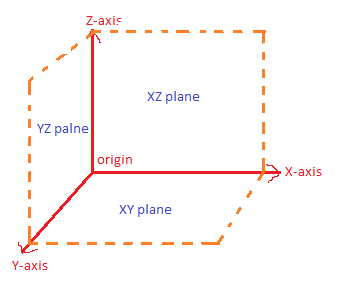Question
Question: Find the vector equation of the coordinate planes....
Find the vector equation of the coordinate planes.
Solution
We know that for a XY plane z coordinate is 0, for an YZ plane x coordinate is 0 and for a ZX plane y coordinate is 0.
Complete step-by-step answer:
Observe the figure given below.

From the figure above we observe that the Z-axis is perpendicular to the XY plane, Y-axis is perpendicular to the XZ plane and X-axis is perpendicular to YZ plane.
Let r=ai∧+bj∧+ck∧ is a position vector in the plane.
Let i∧ be the unit vector parallel to the X-axis, j∧ be the unit vector parallel to the Y-axis and k∧ be the unit vector parallel to Z-axis respectively.

For an XY plane:
Unit vector parallel to the z axis is normal to the plane. That is their dot product with XY plane is equal to zero. So the equation of the plane is r.k∧=0 or we know that a point lying on this plane has z coordinate is 0. So the equation can also be written as r=ai∧+bj∧.
Similarly for the other two planes we can write.
For an YZ plane:
Unit vector parallel to the x axis is normal to the plane. That is, their dot product with the YZ plane is equal to zero. So the equation of the plane is r.i∧=0 or we know that a point lying on this plane has x coordinate is 0. So the equation can also be written as r=bj∧+ck∧.
For an XZ plane:
Unit vector parallel to the z axis is normal to the plane. That is their dot product with XY plane is equal to zero. So the equation of the plane is r.j∧=0 or we know that a point lying on this plane has z coordinate is 0. So the equation can also be written as r=ai∧+ck∧.
Note: Note that a dot product of a position vector with unit vector parallel to the plane is taken zero here because there is an angle of 90∘ in between them. Unit vector is having value 1.
